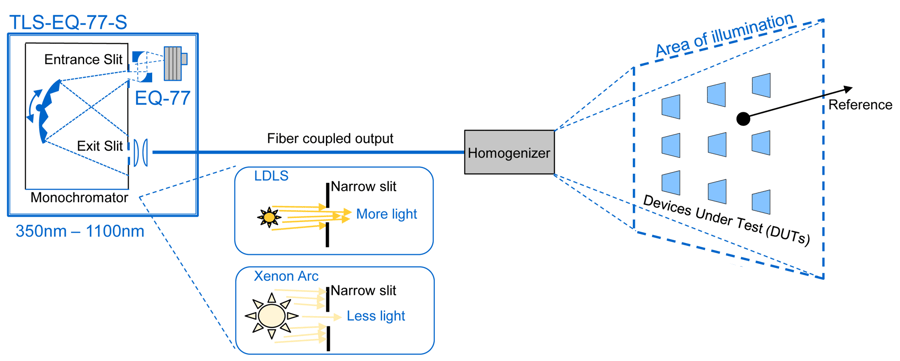Ambient Light Sensor Calibration with Tunable Light Sources
Author: Bill Grube
Fast-Paced Smartphone Market Increases Demand for Ambient Light Sensors
The smartphone market is a fast-paced and highly competitive business in which market leaders must continually innovate with regular releases of “smarter,” more capable phones. Worldwide production of smartphones now exceeds 1.5 billion units per year. While first-to-market features are included in each new product launch, premium brands continue to focus on advancing core functionalities, such as display quality, camera image quality, and battery life. There are typically at least two ambient light sensors in each smartphone to support these core functionalities. Manufacturers must optimize their calibration process to ensure that they can meet the high demand for high performance ambient light sensors.
Energetiq's TLS for Calibration
- High radiance light source with sufficient in-band light flux for high-throughput processes.
- High spatial and long-term spectral stability for consistently accurate measurements.
- Easily integrated and requires infrequent maintenance allowing continuous operation.

Ambient light sensors play a key role in the core functionality of smartphones such as optimizing the onboard camera for use in various lighting conditions.
Contribution of Ambient Sensors to Smartphone Performance
Ambient light sensors also referred to as color or spectral sensors, are simple, low-cost components that have a disproportionately large impact on the performance of high-end smartphones. The sensors are comprised of a small number (2-12) of photodiodes with optical coatings that each transmit a different wavelength band of light. Each photodiode/coating pair is known as a “channel.” A basic ambient light sensor might have only two channels - visible light and near infrared (NIR). In this case, the visible channel detects the level of ambient light and the NIR channel supports proximity sensing. The proximity sensor channel is used to turn off the display when the phone is raised to the user’s ear for a call. More sophisticated sensors have multiple color channels, for example, red, green, and blue, to provide more information about ambient lighting conditions. Ambient light sensors are used to control the brightness of the smartphone display based on ambient conditions, which has a direct impact on the user experience. Precisely controlling display brightness based on ambient lighting conditions also impacts the battery life of the phone. The backlighting of an LCD display accounts for approximately 40% of the overall power consumption of the phone. Therefore, reducing the backlighting, when appropriate, can significantly extend the run time of the phone.
Another important function of ambient light sensors in smartphones is white point matching for the display and onboard camera. The human eyes and mind are capable of processing complex visual information, enabling us to see white objects as “white” under a wide range of lighting conditions. The smartphone relies on data captured by an ambient light sensor to correct images on the display and in digital photos so that white objects appear white in different lighting conditions.
Ambient Light Sensor Calibration Procedure
The calibration process requires illumination of the sensors with narrow-band, or “monochromatic,” light at discrete wavelength steps, covering the spectral range of the sensors. The "monochromatic" light is simultaneously measured by the sensors under test and by a spectrometer, which provides a reference measurement.
The response of each sensor is compared to the reference measurement, providing data that is used to compensate for unit-to-unit variation in the sensors. An example calibration setup, featuring the TLS-EQ-77-S Laser-Driven Tunable Light Source, is shown in Figure 1.

Figure 1: Diagram of a typical ambient light sensor calibration set up.
Energetiq Tunable Light Source Increases Process Throughput
The Energetiq Tunable Light Source (TLS) pairs Energetiq’s unique Laser-Driven Light Source (LDLS™) with a customized monochromator that is matched to the characteristics of the source to maximize coupling efficiency. This combination offers the high resolution required for ambient light sensor calibration, while enabling increased process throughput in the manufacturing environment.
The monochromator of the TLS scans light by wavelength. The width of the entrance and exit slits of the monochromator plays a key role in the tradeoff between wavelength bandwidth and in-band light flux. Wider slits allow more light to pass, but with a broader bandwidth. Conversely, narrower slits enable a narrow bandwidth (high resolution), but also restrict the amount of light that can be delivered. The TLS is unique because of the high spectral radiance of the LDLS around which the product is built. The high radiance of the LDLS source allows more light to be efficiently coupled through a narrow monochromator slit. This means that more light flux can be delivered within a narrow bandwidth than is possible with other tunable light sources. The amount of light delivered through the Energetiq TLS monochromator slit, as compared to that of a typical xenon arc lamp-based system, is illustrated in the two inset diagrams near the center of Figure 1. The spectral radiance of the LDLS is approximately 7-times higher than that of a xenon arc lamp, enabling higher light throughput, and therefore, higher process throughput during sensor calibration.
For effective calibration of ambient light sensors, the bandwidth of the light source must be narrow enough to accurately characterize the performance of the sensors. The standard configuration of the Energetiq TLS provides a bandwidth of 6.5 nm, which has been demonstrated to be effective for the calibration procedure. The area of illumination in which the sensors are calibrated is typically approximately 25 square centimeters. While the bandwidth of the monochromatic light source is a critical parameter for the accuracy of the calibration, it is the in-band light flux that drives process efficiency and throughput. With higher flux, a larger area can be illuminated, and more sensors can be calibrated simultaneously. In this way, the high in-band flux of the Energetiq TLS directly drives profitability in the manufacturing environment.
Additional Benefits of Energetiq TLS
The high light throughput of the Energetiq TLS is not the only benefit for ambient light sensor calibration. The table below highlights several additional benefits.
| Laser-Drive Light Source/TLS Features | Benefits |
|---|---|
|
High radiance
|
High in-band light flux enables high process throughput
|
|
High spatial stability of plasma
|
Consistent output for accurate measurements
|
|
Long-term light flux stability
|
Consistent output for accurate measurements
|
|
Convenient fiber-coupled output
|
Ease of integration
|
|
Infrequent maintenance
|
9,000 hours between bulb replacements (4x longer than xenon bulbs)
|
|
High long-term spectral stability
|
Consistent output for accurate measurements
|



